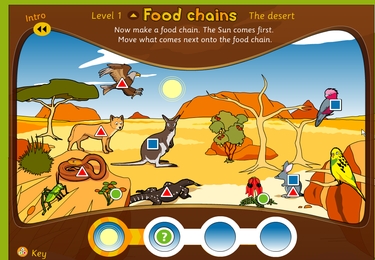Yr 1 Sharing the Planet
To support the unit of inquiry - Sharing the Planet. The resources allow students to organise and classify animal groups.
PIN number: BFMNJD
-


L1134 Animal search
- Published 10/04/2020
- TLF-ID L1134
Sort animals into groups based on their physical features. For example, identify a group of animals that have a backbone, then identify a subset that have slimy skin. Work through a list of features to classify animals and identify a given vertebrate: fish, amphibian, reptile or mammal. This learning object combines four objects in the same series (excluding spoken instructions).
View resource -


L1136 Animal search: is it an amphibian?
- Published 10/04/2020
- TLF-ID L1136
Sort animals into groups based on their physical features. For example, identify a group of animals that have a backbone, then identify a subset where the adult female lays eggs. Work through a list of features to classify animals and identify an amphibian. This learning object is one in a series of four learning objects. The series is also packaged as a combined learning object.
View resource -


L1135 Animal search: is it a reptile?
- Published 10/04/2020
- TLF-ID L1135
Sort animals into groups based on their physical features. For example, identify a group of animals that have a backbone, then identify a subset that have tough, dry skin and are covered in scales. Work through a list of features to classify animals and identify a reptile. This learning object is one in a series of four learning objects. The series is also packaged as a combined learning object.
View resource -


L766 Animal search: is it a mammal?
- Published 10/04/2020
- TLF-ID L766
Sort animals into groups based on their physical features. For example, identify a group of animals that have a backbone, then identify a subset that make milk to feed their babies. Work through a list of features to classify animals and identify a mammal. This learning object is one in a series of four learning objects. The series is also packaged as a combined learning object.
View resource -


L1137 Animal search: is it a fish?
- Published 10/04/2020
- TLF-ID L1137
Sort animals into groups based on their physical features. For example, identify a group of animals that have a backbone, then identify a subset that breathe with gills. Work through a list of features to classify animals and identify a fish. This learning object is one in a series of four learning objects. The series is also packaged as a combined learning object.
View resource -
![Animal search: is it a mammal? [ESL]](/ec/viewing/L8551/support_files/thumb.jpg?useDefault)

L8551 Animal search: is it a mammal? [ESL]
- Published 10/04/2020
- TLF-ID L8551
Sort animals into groups based on their physical features. For example, identify a group of animals that have a backbone, then identify a subset that make milk to feed their babies. Work through a list of features to classify animals and identify a mammal. This learning object is one in a series of four learning objects.
View resource -


L1146 Food chains: the forest
- Published 10/04/2020
- TLF-ID L1146
Create food chains to describe interactions within a forest environment. Look at the feeding patterns between plants and animals. Arrange producers and consumers into a food chain such as tree>caterpillar>kookaburra. This learning object is one in a series of six objects.
View resource -


L1143 Food chains: the desert
- Published 28/01/2014
- TLF-ID L1143
Create food chains to describe interactions within a desert environment. Look at the feeding patterns between plants and animals. Arrange producers and consumers into a food chain such as spinifex>bilby>eagle. This learning object is one in a series of six objects.
View resource -


L1147 Food chains: what is a food chain?
- Published 10/04/2020
- TLF-ID L1147
Explore the idea of food chains to describe interactions. See an energy source, producer and consumers arranged into a food chain. This learning object is one in a series of six objects.
View resource -


L1446 Ecosystem balance
- Published 21/01/2016
- TLF-ID L1446
Explore how plants and animals interact in three Tasmanian ecosystems: a dry forest, rainforest and seaweed community. Look at species descriptions of plants and animals that live there. Increase or decrease the population of a species and compare the effects on other species within the ecosystem.
View resource -


L1144 Food chains: the wetlands
- Published 10/04/2020
- TLF-ID L1144
Create food chains to describe interactions in a pond. Look at the feeding patterns between plants and animals. Arrange producers and consumers into a food chain such as algae>tadpole>turtle. This learning object is one in a series of six objects.
View resource -
![New developments [includes spoken instructions]](/ec/viewing/L16/support_files/thumb.jpg?useDefault)

L16 New developments [includes spoken instructions]
- Published 10/04/2020
- TLF-ID L16
Survey populations of mammals and birds. Test how urban development impacts on wildlife. Notice the balance between development and wildlife conservation. Explore interactions between national parks, creeks, wetlands, bridges, towns and farms.
View resource
